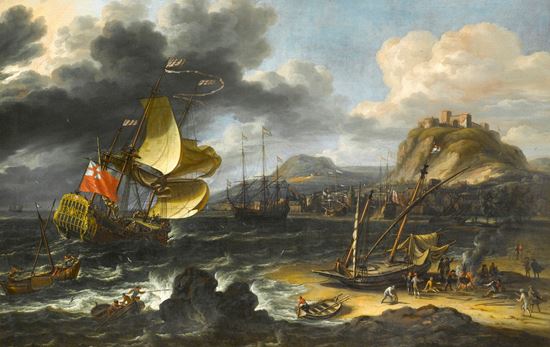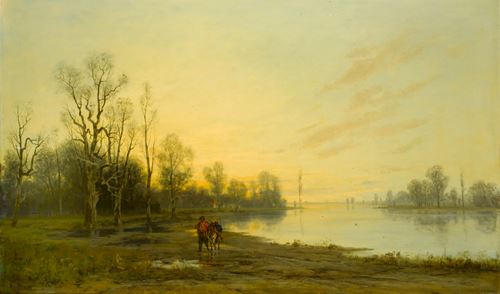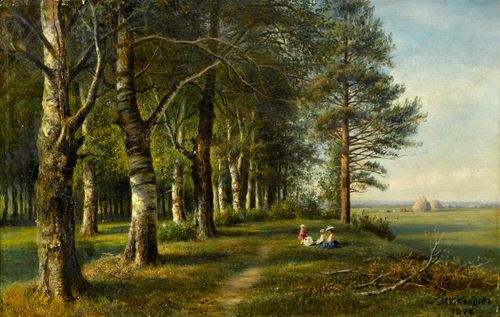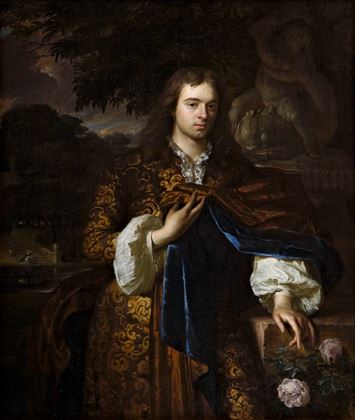orenzo A. Castro
(Antwerp 1672 - 1686)
An English Man-O’War Running into a Crowded Continental Port
signed ‘L A Castro F’ (lower right)
oil on canvas
71.8 x 111.1 cm (28¼ x 43¾ in)
Lorenzo Castro’s painting shows an English man-o’war entering an anonymous port. The sea is dark and choppy and storm clouds hover overhead, crowding out the bright sky on the right-hand side of the work. The tricky conditions have resulted in many of the figures in the painting struggling to control the boats. In the foreground, a man tries to push his rowing boat away from the rocks whilst his companions row desperately against the waves. Their efforts are echoed by the frenzied activity that takes place on the man-o’war, where the sails are being lowered and the ship is being prepared to enter the port. In the background is the port itself, where numerous other large vessels already anchored. On the right-hand side a ship has been dragged onto the shore and its crew have built a fire, behind, an abandoned ship has fallen on its side.
A man-o’war was the most powerful type of armed ship from the sixteenth to the nineteenth centuries, identifiable because it was armed with cannons and propelled primarily by sails, as opposed to a galley which is propelled primarily by oars. The extensive decoration on the stern of the ship is typical of a man-o’ war, making them easily recognisable, and the British Navy often found it difficult to disguise them because of the profusion of carved works. In fact, ‘it seems to have been the rule that any ship built for the Navy in the seventeenth century was heavily ornamented’.1
Although traditionally presumed to be a capriccio, An English Man-O’War Running into a Crowded Continental Port is made all the more intriguing by the flags flying from the mastheads of the arriving English ship. Instead of the usual jacks of the period, the vessel is wearing what are termed 'the "Stuart" colours', and although it remains unclear what precisely these striped flags denoted, it is possible that they alluded to an allegiance to the Stuart Kings of England in general, and to James II in particular after his enforced abdication in favour of William III and Queen Mary.
Castro was primarily a maritime painter, and his work within this genre was quite diverse. The Battle of Actium, 2nd September 31BC provides us with a particularly contrasting work to An English Man-O’War Running into a Crowded Continental Port, not only in terms of subject matter, but also in regard to composition and mood. Rather than a traditional marine landscape with a study of weather conditions, the work is more typical of history painting, with the focus on the frenzied battle. Castro’s A Galley off a Mediterranean Port however provides us with an example of a work that contains many of the elements present in An English Man-O’War Running into a Crowded Continental Port, not least in the close and detailed study of a large ship, which acts as the focus of the work. Again this port is crowded by ships and, as well as the numerous and diverse sized vessels, we also see details of the human activity of the port. Dark clouds are encroaching on the bright blue sky, a contrast that Castro employs in both works.
Castro, of Portuguese-Jewish descent, was born in Antwerp. It was here that he received his early training, possibly from his father Sebastian, being recorded in 1664 as a member of the Guild of St. Luke in that city. He travelled extensively to Lisbon, Genoa, Sicily and Malta, and his work certainly reflects a knowledge of Mediterranean regions, although many of the elements of his landscapes have a northern character. He appears to have settled in England between 1672 and 1686, although a Lawrence Castro is recorded as late as 1695. In England he painted Mediterranean scenes for a specific market and many of his works are held in English private and public collections. In style, Castro was excellent with figures and, indeed, was an accomplished portrait painter. As evident in An English Man-O’War Running into a Crowded Continental Port he used the contrast between light and dark to intensify his scenes. He was influenced by Dutch masters and by the Willaerts family in particular.
1 L. G. Carr Laughton, Old Ship Figure-Heads and Sterns, Courier Dove Publications, 2001.
Lorenzo Castro’s painting shows an English man-o’war entering an anonymous port. The sea is dark and choppy and storm clouds hover overhead, crowding out the bright sky on the right-hand side of the work. The tricky conditions have resulted in many of the figures in the painting struggling to control the boats. In the foreground, a man tries to push his rowing boat away from the rocks whilst his companions row desperately against the waves. Their efforts are echoed by the frenzied activity that takes place on the man-o’war, where the sails are being lowered and the ship is being prepared to enter the port. In the background is the port itself, where numerous other large vessels already anchored. On the right-hand side a ship has been dragged onto the shore and its crew have built a fire, behind, an abandoned ship has fallen on its side.
A man-o’war was the most powerful type of armed ship from the sixteenth to the nineteenth centuries, identifiable because it was armed with cannons and propelled primarily by sails, as opposed to a galley which is propelled primarily by oars. The extensive decoration on the stern of the ship is typical of a man-o’ war, making them easily recognisable, and the British Navy often found it difficult to disguise them because of the profusion of carved works. In fact, ‘it seems to have been the rule that any ship built for the Navy in the seventeenth century was heavily ornamented’.1
Although traditionally presumed to be a capriccio, An English Man-O’War Running into a Crowded Continental Port is made all the more intriguing by the flags flying from the mastheads of the arriving English ship. Instead of the usual jacks of the period, the vessel is wearing what are termed 'the "Stuart" colours', and although it remains unclear what precisely these striped flags denoted, it is possible that they alluded to an allegiance to the Stuart Kings of England in general, and to James II in particular after his enforced abdication in favour of William III and Queen Mary.
Castro was primarily a maritime painter, and his work within this genre was quite diverse. The Battle of Actium, 2nd September 31BC provides us with a particularly contrasting work to An English Man-O’War Running into a Crowded Continental Port, not only in terms of subject matter, but also in regard to composition and mood. Rather than a traditional marine landscape with a study of weather conditions, the work is more typical of history painting, with the focus on the frenzied battle. Castro’s A Galley off a Mediterranean Port however provides us with an example of a work that contains many of the elements present in An English Man-O’War Running into a Crowded Continental Port, not least in the close and detailed study of a large ship, which acts as the focus of the work. Again this port is crowded by ships and, as well as the numerous and diverse sized vessels, we also see details of the human activity of the port. Dark clouds are encroaching on the bright blue sky, a contrast that Castro employs in both works.
Castro, of Portuguese-Jewish descent, was born in Antwerp. It was here that he received his early training, possibly from his father Sebastian, being recorded in 1664 as a member of the Guild of St. Luke in that city. He travelled extensively to Lisbon, Genoa, Sicily and Malta, and his work certainly reflects a knowledge of Mediterranean regions, although many of the elements of his landscapes have a northern character. He appears to have settled in England between 1672 and 1686, although a Lawrence Castro is recorded as late as 1695. In England he painted Mediterranean scenes for a specific market and many of his works are held in English private and public collections. In style, Castro was excellent with figures and, indeed, was an accomplished portrait painter. As evident in An English Man-O’War Running into a Crowded Continental Port he used the contrast between light and dark to intensify his scenes. He was influenced by Dutch masters and by the Willaerts family in particular.
1 L. G. Carr Laughton, Old Ship Figure-Heads and Sterns, Courier Dove Publications, 2001.





 contact
contact +44 20 7313 8040
+44 20 7313 8040









